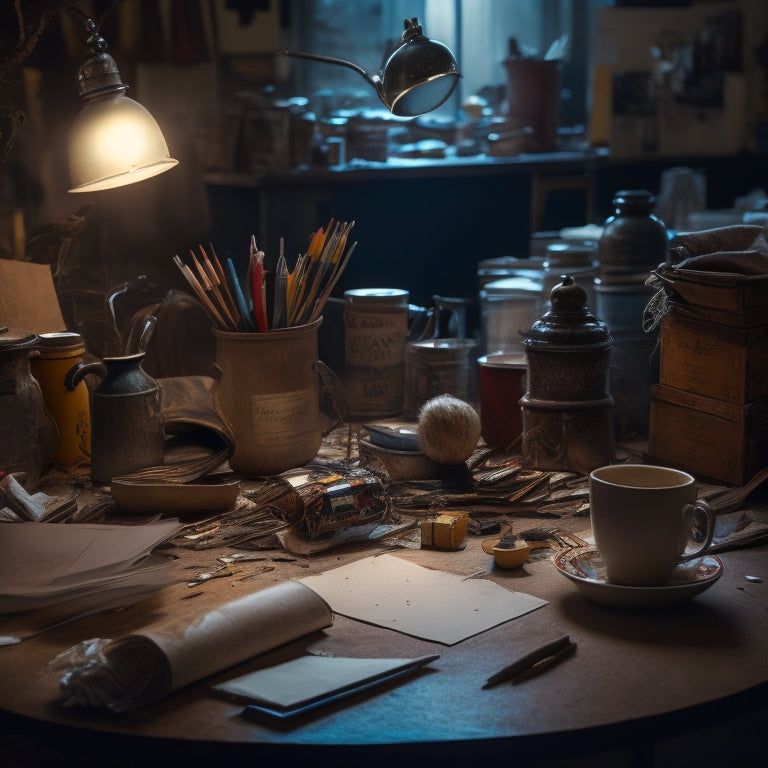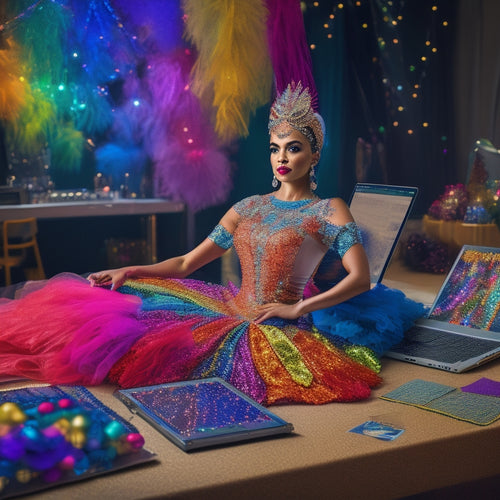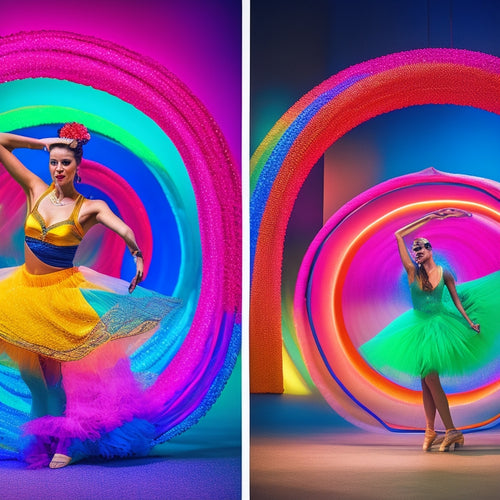
What's Holding You Back From Finishing Art Projects?
Share
You're stuck in a cycle of unfinished art projects, and it's likely due to one of several common pitfalls that creep up on even the most enthusiastic creatives. Are you struggling to set clear goals, or are you paralyzed by fear of imperfection? Maybe you're overwhelmed by multiple projects or plagued by poor time management. Perhaps distractions are derailing your creative flow, or perfectionism is suffocating your vision. Whatever the reason, it's time to identify the roadblocks and break free from the cycle of unfinished projects. Explore the underlying causes, and you'll uncover the key to finally completing your art projects.
Key Takeaways
• Unclear goals and direction can lead to a lack of motivation and focus, hindering project completion.
• Fear of imperfection and criticism can paralyze artists, causing them to abandon projects or struggle to make progress.
• Poor time management and prioritization can result in multiple unfinished projects, causing feelings of overwhelm and guilt.
• Distractions, such as digital temptations, can disrupt creative flow and make it difficult to make progress on art projects.
• Unrealistic expectations and perfectionism can lead to procrastination, burnout, and a lack of motivation to complete art projects.
Lack of Clear Goals Holding
When you're stuck in limbo, struggling to complete an art project, it's often because you're lacking a clear direction or goal, leaving you feeling lost and uncertain about how to move forward. This lack of clarity can be overwhelming, making it difficult to muster the motivation to continue.
That's where goal setting comes in – a powerful tool to help you regain momentum. By setting specific, achievable goals, you'll create a roadmap for your project, breaking it down into manageable tasks that'll guide you towards completion.
One effective way to visualize your goals is through the creation of a vision board. This visual representation of your aspirations will help you stay focused, inspired, and committed to your artistic vision.
Fear of Imperfection Paralyzing Progress
As you refocus on your art project with renewed clarity and direction, a new obstacle emerges: the fear of imperfection, which can be just as debilitating as a lack of clear goals, quietly sabotaging your progress and eroding your confidence.
This fear can manifest in different ways, but ultimately, it's a fear of not meeting your own expectations. It's the voice in your head that whispers, "What if it's not good enough?" or "What if I make a mistake?" This fear can be paralyzing, causing you to procrastinate or abandon your project altogether.
| Fear | Freedom |
|---|---|
| Fear of imperfection | Embrace the beauty of imperfection |
| Fear of criticism | Share your art with courage |
| Fear of failure | Learn from mistakes and grow |
To overcome this fear, remember that creative freedom is not about being perfect; it's about embracing the process and having the artistic courage to share your work with the world. By doing so, you'll discover that the act of creating is more valuable than the outcome. So, take a deep breath, silence that inner critic, and let your art shine.
Overwhelmed by Multiple Projects
You're stuck in the midst of multiple projects, and it's overwhelming. You're worried that if you focus on one, the others will wither away, unfinished and forgotten.
As you struggle to make progress on any of them, you're lost in the middle, unsure of how to move forward without abandoning some of your creative ideas.
Lost in the Middle
Multiple art projects swirling in your mind can feel like being trapped in a whirlwind, making it difficult to pinpoint which one to focus on next. You're not alone in this predicament. Many creatives struggle with the 'multiple project syndrome,' where enthusiasm and inspiration lead to an overwhelming number of projects, ultimately hindering progress on any one of them.
As you navigate this midpoint, it's essential to acknowledge the Creative Blocks that are holding you back.
Take a step back, and conduct a Midpoint Analysis of each project.
Ask yourself:
What sparked my initial excitement for this project?
What's the core message or theme I want to convey?
What's the ultimate goal I want to achieve with this piece?
Fear of Abandonment
Fear of abandonment creeps in when you're torn between pursuing a new idea and risking the progress you've made on existing projects, leaving you feeling stuck and uncertain about which path to take.
You've invested emotional attachment in each project, and the thought of abandoning any of them feels like a personal failure. This fear prevents you from committing fully to a single project, fearing that the others will wither away, unloved and unfinished.
You crave creative validation, but with multiple projects vying for your attention, it's hard to know where to focus. You worry that if you choose one project over the others, you'll be abandoning the emotional investment you've made in the others.
This fear of abandonment can be overwhelming, causing you to procrastinate and make little progress on any of your projects.
Inadequate Time Management Skills
You're not alone if you find yourself struggling to manage your time effectively, constantly juggling multiple art projects and deadlines.
It's easy to get caught up in the creative process, but poor prioritization and procrastination habits can quickly turn your artistic vision into a stressful nightmare.
Prioritizing Tasks Poorly
When deadlines loom, your to-do list can quickly become a jumbled mess, making it tough to pinpoint which tasks to tackle first. You're not alone in this struggle.
Prioritizing tasks poorly can lead to Task Overload, where your list grows longer, and your motivation dwindles. It's easy to get caught up in the excitement of starting a new project, but without a clear plan, you'll find yourself drowning in tasks.
To break free from this cycle, take a step back and reassess your priorities. Identify the most critical tasks that'll drive your project forward. Be honest with yourself – what can wait, and what can't? Don't be afraid to shift your priorities as needed.
A Priority Shift can be a game-changer, helping you refocus on what truly matters. By streamlining your tasks and tackling the most critical ones first, you'll make steady progress and regain control over your project.
Procrastination Habits Forming
As the project timeline stretches out before you, inadequate time management skills can quietly sabotage your progress, allowing procrastination habits to take root and flourish. You mightn't even realize it's happening, but before you know it, you're stuck in a cycle of delay and distraction.
This is where habit loops come in – patterns of behavior that become automatic, making it harder to make progress on your art project. To break free from these loops, you need to identify the underlying mindset that's driving your procrastination. Are you afraid of failure? Perfectionism getting the better of you? Once you pinpoint the root cause, you can start working on mindset shifts.
This might mean reframing your thinking, setting realistic goals, or finding accountability. Remember, it's not about being perfect; it's about making progress. By acknowledging your weaknesses and implementing small changes, you can train yourself to stay focused and motivated.
With time and practice, you'll develop healthier habits, and your art project will start to take shape.
Distractions Derailing Creative Flow
At least 75% of art projects stall due to distractions that hijack your creative flow, leaving you frustrated and wondering why you can't seem to make progress. You're not alone in this struggle.
As an artist, you're constantly tempted by the siren songs of social media, email notifications, and endless scrolling. Digital overwhelm can be overwhelming, making it difficult to focus on your art. Before you know it, hours have passed, and you've accomplished nothing.
You try to regain momentum, but the constant ping of notifications and the pressure to stay connected can be debilitating. You feel like you're drowning in a sea of digital noise, with your art project collecting dust in the background.
It's time to take control back. Identify the distractions that derail your creative flow and eliminate them. Create a conducive environment that fosters focus and inspiration. By doing so, you'll be able to tap into your creative potential and bring your art project to life.
Perfectionism Preventing Completion
You've poured your heart and soul into your art project, but now it's stuck in an endless cycle of revisions, as the pursuit of perfectionism threatens to suffocate your creative vision.
You're not alone; many fearful artists get trapped in this vicious cycle, paralyzed by the pressure to create something flawless. The fear of imperfection can be overwhelming, causing you to doubt your skills and question your artistic worth.
Unrealistic standards can lead to an unhealthy obsession with detail, making it impossible to meet your own expectations.
As you aim for perfection, you may find yourself overthinking every brushstroke, every note, or every sentence. This constant self-criticism can be exhausting, draining your creative energy and stifling your growth.
It's crucial to recognize that perfection is an unattainable myth, and that your unique voice and perspective are what make your art valuable. By embracing imperfection and letting go of unrealistic standards, you can break free from the cycle of revisions and finally bring your project to life.
Unrealistic Expectations Sabotaging Success
Your expectations of what your art project should achieve can become a heavy burden, weighing you down with unattainable goals and setting you up for disappointment. When you're dreaming big, it's easy to overextend yourself and set high standards that are nearly impossible to meet. But what happens when you inevitably fall short? You're left feeling defeated and unmotivated, wondering why you even started in the first place.
Here are some signs that your expectations might be sabotaging your success:
-
Unreal hopes: You're expecting your project to be a masterpiece, a game-changer, or a viral sensation.
-
Overextending oneself: You're committing to an unrealistic timeline or scope, setting yourself up for burnout and frustration.
-
Aiming for perfection: You're aiming for perfection, but in reality, it's an unattainable goal that's holding you back from finishing.
- Dreaming too big: You're trying to tackle too much, too soon, and it's overwhelming you.
Procrastination Hiding Behind Excuses
As you struggle to meet your lofty expectations, it's easy to get stuck in a cycle of procrastination, where every unfinished task is accompanied by a convincing excuse that sounds suspiciously like a legitimate reason. You're not alone in this struggle. Many creatives master the art of excuse-making, convincing themselves that they're not procrastinating, but rather waiting for the perfect moment, inspiration, or resources.
| Excuse | Reality |
|---|---|
| I need more experience before I start. | You're afraid of failure and lack of perfection. |
| I'm waiting for inspiration to strike. | You're avoiding the hard work of showing up and creating. |
| I need the right tools and software. | You're using lack of resources as an excuse to delay. |
| I'm too busy with other commitments. | You're prioritizing other tasks over your art. |
| I'm just not feeling motivated. | You're struggling with creative avoidance and fear of failure. |
Don't let excuses hold you back from finishing your art projects. Recognize the patterns of creative avoidance and excuse mastery, and gently push yourself to take small steps towards completion. Remember, every small step forward is a victory against procrastination.
Frequently Asked Questions
How Do I Prioritize Tasks When Multiple Projects Have Tight Deadlines?
"When juggling multiple projects with tight deadlines, you prioritize tasks by grouping similar tasks together, aka task batching, and allocate specific time slots for each, mastering time management and calming your creative chaos."
Can I Overcome Creative Blocks Caused by Self-Doubt and Criticism?
"Listen, you're not alone in this creative struggle. When self-doubt whispers 'you're not good enough,' it's your inner critic fueling a fear mindset. Acknowledge it, and gently redirect your thoughts to 'I'm capable, I'm learning, and I'll get there.'"
What if I'm Not Inspired by the Project I'm Working on Anymore?
When you're no longer inspired by your project, it's normal to feel stuck. You're not alone - losing momentum can be a sign of growth, a chance to redefine your artistic identity and uncover what truly sparks your creativity.
How Can I Avoid Burnout When Working on a Long-Term Art Project?
"Can you truly create your best work when exhaustion whispers 'give up'? Probably not. To avoid burnout, you're wise to prioritize time management, setting realistic goals, and flexible deadlines, ensuring your passion project doesn't become a draining chore."
Can I Still Be Creative if I'm Not a Traditionally "Artistic" Person?
You don't need a traditional art background to be creative! Explore alternative mediums like writing, photography, or even gardening - your unique perspective will shine through, and that's what makes it art, regardless of your non-artistic background.
Related Posts
-

Design Stunning Dance Costumes With Online Tutorials
With online tutorials, you're just a click away from accessing stunning dance costumes that mesmerize the audience. D...
-

Digital Marketing Strategies for Dance Business Success
You're about to unleash the full potential of your dance business by leveraging digital marketing strategies that wil...
-

Dance Props to Take Choreography to the Next Level
Dance props are your secret weapons for altering choreography into a breathtaking masterpiece. They breathe life into...


